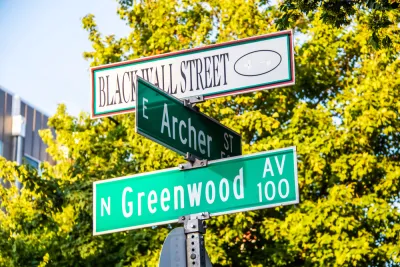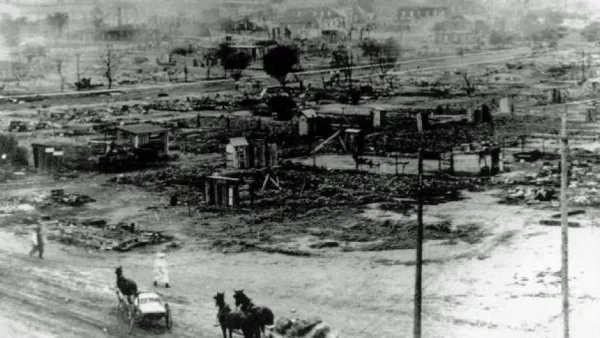After the Tulsa Race Massacre, Greenwood rebuilt strong. Then came "urban renewal."

The Tulsa Daily World’s June 2, 1921 morning edition headline read: “Dead Estimated at 100: City is Quiet. $2000 to Start Fund for Relief. Negros Gladly Accept Guards. 5,000 Negro Refugees Guarded in Camp at County Fairgrounds.”
Fewer than 24 hours after Ku Klux Klan leaders — along with the Tulsa Police Department and the Oklahoma National Guard — carried out the nation’s deadliest and most destructive massacre, Tulsa’s paper of record was already at work crafting a narrative that would shape the way that the city would think about the massacre in Greenwood for the next 100 years.
Thanks to recent scholarship and pop culture depictions of the massacre in Greenwood, more and more Americans are coming to know the story of the Tulsa Race Massacre that destroyed Black Wall Street. But the common narrative — that the massacre destroyed the neighborhood and it never recovered — is incorrect. In fact, Greenwood’s resilient residents rebuilt their community almost immediately after the massacre — in defiance of hastily-enacted racist zoning codes — giving rise to the popular use of the neighborhood’s moniker of Black Wall Street after, not before, the massacre. And while a price cannot be put on the 300 lives lost, the violence that really destroyed Black Wall Street wasn’t physical, but structural.
FULL STORY: Black Wall Street's Second Destruction

National Parks Layoffs Will Cause Communities to Lose Billions
Thousands of essential park workers were laid off this week, just before the busy spring break season.

Retro-silient?: America’s First “Eco-burb,” The Woodlands Turns 50
A master-planned community north of Houston offers lessons on green infrastructure and resilient design, but falls short of its founder’s lofty affordability and walkability goals.

Delivering for America Plan Will Downgrade Mail Service in at Least 49.5 Percent of Zip Codes
Republican and Democrat lawmakers criticize the plan for its disproportionate negative impact on rural communities.

Test News Post 1
This is a summary

Test News Headline 46
Test for the image on the front page.

Balancing Bombs and Butterflies: How the National Guard Protects a Rare Species
The National Guard at Fort Indiantown Gap uses GIS technology and land management strategies to balance military training with conservation efforts, ensuring the survival of the rare eastern regal fritillary butterfly.
Urban Design for Planners 1: Software Tools
This six-course series explores essential urban design concepts using open source software and equips planners with the tools they need to participate fully in the urban design process.
Planning for Universal Design
Learn the tools for implementing Universal Design in planning regulations.
EMC Planning Group, Inc.
Planetizen
Planetizen
Mpact (formerly Rail~Volution)
Great Falls Development Authority, Inc.
HUDs Office of Policy Development and Research
NYU Wagner Graduate School of Public Service





























